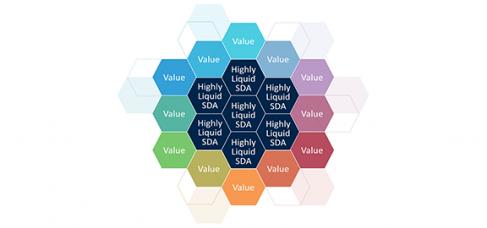Healthcare IQ Navigates Rapid Change
Healthcare IQ[foot]See additional detail on Healthcare IQ’s transformation over the past decade in B. H. Wixom, C. M. Beath, Ja-Nae Duane, and Ida A. Someh, “Healthcare IQ: Sensing and Responding to Change,” MIT CISR Working Paper No. 458 (forthcoming).[/foot] is a privately held data and analytics company that competes in the data analytics industry. For over thirty years the company’s primary customers have been hospitals that need help managing and making sense of their data. Healthcare IQ provides its customers with information solutions that vary from data preparation and reporting to analytics and advisory services. At the heart of the company’s offerings are two key data assets: a hospital supply chain data asset (detailed records of historical hospital spending) and a product catalog data asset (a comprehensive catalog of medical products).
The hospital supply chain data asset, sourced mainly from Healthcare IQ customer hospitals, contains records of what the hospitals have historically spent on medical products. This data asset includes records of $30 billion in longitudinal annual spend data collected from the 2,400 healthcare facilities associated with Healthcare IQ's customer hospitals. Supply chain data includes data found in hospitals’ invoices, purchase orders, pricing contracts, item and vendor master files, electronic health records, and payor reimbursements. Once Healthcare IQ has blinded and aggregated the pricing and cost data, the company’s contracts with its customers give Healthcare IQ ownership of the data it manages and allow the company to use the data for benchmarking and analytics purposes.
The product catalog data asset indexes medical products along with their attributes and relationships, and calculated benchmarks such as average pricing and average reimbursement amount. This data asset contains data on nearly six million unique healthcare products produced by more than 25,000 manufacturers. Healthcare IQ builds the product catalog from spend data provided by the company’s customers, as well as from product data originally provided by distributor and manufacturer partners but more recently scraped from manufacturer catalogs and other internet sources. In its early years, Healthcare IQ staffed a large content team of domain experts, including former hospital procurement analysts and healthcare clinicians, to update, validate, and enrich the company’s product data. After the company shifted to collecting product data from thousands of internet sources, its engineers created an AI-based process using natural language processing algorithms and machine learning to do almost all this work. Today, a smaller content team helps with model training and other tasks requiring human attention.
Healthcare IQ customers access the hospital supply chain and product catalog data assets using a suite of software tools that the company regularly upgrades with new and better reporting and analysis features. Customers use the tools and data assets to identify ways to save money and improve the quality of medical care.
Healthcare IQ assigns each new customer a customer care representative who ensures that the customer achieves desired savings goals from Healthcare IQ offerings. The representative monitors the hospital supply chain data asset to identify where the customer is realizing cost savings and where additional opportunities exist.
When Healthcare IQ customers need additional assistance using the company’s self-service tools and data assets, they contact the IQ Center, Healthcare IQ’s team of financial and clinical analysts. During the COVID-19 pandemic, the IQ Center experienced a substantial spike in information requests from customers with pandemic-related supplies questions. In many cases, IQ Center staff were able to draw answers from the hospital supply chain and product catalog data assets, which together maintain what products are being used in a hospital and by whom. For example, to help a customer seeking substitutes for products in short supply, IQ Center staff could reference the data assets to surface alternatives in use elsewhere in the hospital.
IQ Center staff also flag potential improvements in the assets. For example, when the US government introduced new value-based care legislation that pressured hospitals to manage costs relative to clinical value, Healthcare IQ customers started asking new questions about cost savings in the context of patient health outcomes. Customer requests helped Healthcare IQ understand that it needed to extend its hospital supply chain data asset to include outcomes from electronic health records and payor reimbursements.
Healthcare IQ’s business development staff routinely meet with current and potential customers, listen to their strategic supply chain management needs, and describe the company’s data assets and tools. These staff pay close attention to what resonates, as unmet needs represent opportunities. For example, in one such business development meeting, Healthcare IQ discovered that its ability to organize and quickly make sense of a hospital’s data was appealing to professional services firms that specialized in helping hospitals manage their costs. Such firms commonly engaged in tedious and time-consuming data wrangling before they could begin performing high-value analysis and advisory services—and Healthcare IQ’s data management services could eliminate weeks of data wrangling. In 2016, Healthcare IQ established an arrangement with one professional services firm to transform client data for the firm’s consultants. The consultants would provide six-to-twelve months of a client’s data to Healthcare IQ, which would then integrate, standardize, and curate the data, and produce a report of cost savings opportunities. The consultants would review this report with their hospital client and propose an action plan to achieve cost savings. By 2022, Healthcare IQ had parlayed this set of services into a standalone service line that the company now provides to multiple consulting firms.









